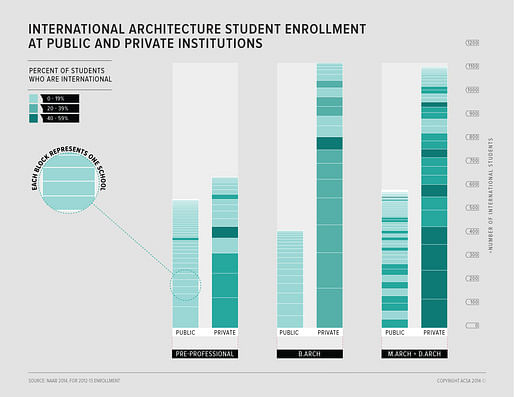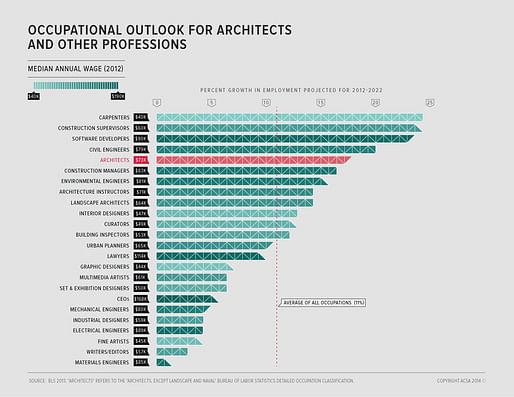
The ACSA Atlas is an ongoing project examining architectural education in relationship to demographics, higher education, the profession, and the economy. We've just released a new set of graphics!
 This is a simple count of architects per state compared with population per state. (See in full size)
This is a simple count of architects per state compared with population per state. (See in full size)
 Numbers of architecture students by region, in comparison with architects per capita (darker teal is more architects per capita). (See in full size)
Numbers of architecture students by region, in comparison with architects per capita (darker teal is more architects per capita). (See in full size)
 Simple roundup of student ethnicity by region--we'll also be doing more detailed work in this area in the next couple of months. (See in full size)
Simple roundup of student ethnicity by region--we'll also be doing more detailed work in this area in the next couple of months. (See in full size)

In relation to other disciplines in the built environment, architecture is big, but we're not alone! Here's a snapshot of the numbers of 2012 graduates by discipline. (See in full size)
 The solid parts of this stacked chart show architecture-related degrees earned, from 1970 to 2012, and the lines show all fields, on a differently scaled axis. We've called out the 10 year span from 1992 to 2012--during this time, architecture has not grown as fast as higher education as a whole. (See in full size)
The solid parts of this stacked chart show architecture-related degrees earned, from 1970 to 2012, and the lines show all fields, on a differently scaled axis. We've called out the 10 year span from 1992 to 2012--during this time, architecture has not grown as fast as higher education as a whole. (See in full size)

The bar height is the count of international students, and each block represents one school, colored according to its percent of international students (darker means more). There are more international students in M.Arch programs versus B.Arch and pre-professional programs, but the main difference is that private schools have much higher numbers and of international students than public schools. (See in full size)

Our ranks of full-time tenure-track assistant professors are also much less diverse than our student bodies.This chart shows the level of overrepresentation or underrepresentation of demographic groups among doctoral and lower level degree holders, as well as full-time tenure-track assistant professor positions at architecture schools, divided by ethnicity and gender.The red line is party relative to the numbers of each group in the US population, so those above the red line are overrepresented relative to their numbers in the U.S. population and those below are underrepresented.
For example, while black and Hispanic women are earning doctorates in architecture-related fields at around ½ the rate you’d expect based on their numbers in the population, they’re occupying assistant professor roles at less than ¼ this rate. This is a big drop-off. If you look at black women, in particular, architecture is doing much worse here than average, across all fields in higher education (marked for each bar with a thin black line). (See in full size)

Here we're looking at DesignIntelligence data on salaries in the profession, from 2008 through the current year. The yellow strip at the bottom is intern architects in their first through third years, and you can see their salaries are basically at the same level of administrative assistants--and in fact, recent graduates have actually lost some ground relative to administrative assistants since 2008. (See in full size)

This is a niche graphic. We're looking at how much architects earn when they're working in architect role (not other designer roles, teaching, or anything else, just the architecture occupation as defined by the Bureau of Labor Statistics), in different industries. (See in full size)

The economic outlook for architects is good! The Bureau of Labor Statistics has forecasted 17% growth for architects for the 10 years between 2012 and 2022. This is significantly more robust than the average for all occupations, indicated by the red line at 11%. Alongside architecture we’re showing a range of related design and built environment professions, and architecture is doing well within this subset as well. (See in full size)
The slides were produced by the Association of Collegiate Schools of Architecture with graphic design by Arielle Assouline-Lichten and Ben Daniel Brady, recent M.Arch graduates and founders of the Brooklyn-based multidisciplinary design firm Slash Projects.
We hope you take a look at this data that we've visualized, and let us know what you think and what you'd like us to work on next. You can also visit the ACSA website for the full-resolution slides and more data projects.
-Lian Chikako Chang (ACSA Director of Research + Information)
The Association of Collegiate Schools of Architecture is a nonprofit membership organization, founded in 1912 to advance the quality of architectural education. Our members are over 250 schools, including all accredited programs in the USA and Canada, schools seeking accreditation, and non-accredited and international programs--representing over 40,000 architecture faculty and students.
2 Comments
These ACSA analysis and graphics are killing it! I love having this information from a reliable source and so easy to access.
I'm shocked to see that while there was a huge drop off in architecture student numbers after the 1990 market crash, the numbers from 2008 until now have done nothing but go up.
Some very dense information here - not always easy to absorb without spending much time with the charts.
Block this user
Are you sure you want to block this user and hide all related comments throughout the site?
Archinect
This is your first comment on Archinect. Your comment will be visible once approved.